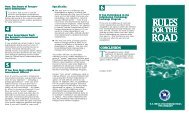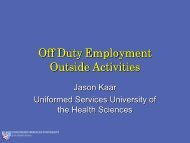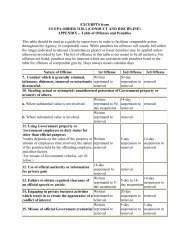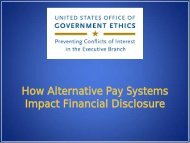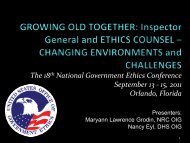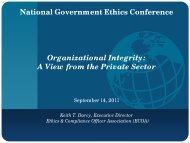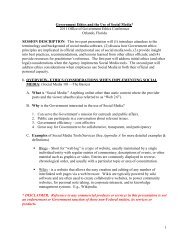Roadmap & Planning Workbook - US Office of Government Ethics
Roadmap & Planning Workbook - US Office of Government Ethics
Roadmap & Planning Workbook - US Office of Government Ethics
Create successful ePaper yourself
Turn your PDF publications into a flip-book with our unique Google optimized e-Paper software.
“planning paralysis.” Instead, the project manager should set realistic timeframes<br />
and develop a schedule to control the planning process.<br />
2 Identify initiative team or workgroup: If not done previously, identify who will<br />
assist and what their roles and responsibilities are. Assemble and involve them in<br />
these products.<br />
3 Scope review: Carefully review your prior scope. Consider:<br />
a. A scope statement that provides scope definition with supporting detail;<br />
b. Objectives (measures for success) [Objectives are yardsticks to measure<br />
success. They are a critical part because they help the team, stakeholders, and<br />
users assess whether or not the finished eFiling product does what it was<br />
supposed to do, how well it works, and, ultimately, if it is a success. Thus,<br />
objectives must include measures <strong>of</strong> quality, time, cost, performance, reliability<br />
and/or functionality.]; and a<br />
c. Scope Management Plan to control scope changes and avoid “scope creep.”<br />
Note: once a project starts:<br />
• Those involved learn more and realize that what they originally asked<br />
for may not be exactly what is needed, so a change in scope or<br />
requirements is necessary;<br />
• The business needs may change so that what was originally “in scope”<br />
is no longer needed (e.g., OGE changes FDR regulations or definitions<br />
– don’t report diversified mutual funds on OGE 450); or<br />
• Newer technology is available (e.g., another agency has a better<br />
solution).<br />
4 Schedule & Milestones: Add detail to the earlier preliminary schedule with more<br />
milestones and the projected date <strong>of</strong> full agency-wide use <strong>of</strong> the eFiling system. If<br />
already out <strong>of</strong> FDR filing season (e.g., after 15 Feb for OGE 450 or after 15 May<br />
for OGE 278) consider focusing on New Entrant filers at first.<br />
5 Budget: Estimate the expected direct and indirect costs for planning (e.g., any<br />
outside agency consultants), for obtaining the eFiling solution, for implementing it,<br />
and for sustaining and operating it.<br />
6 Risk Management Plan: Identify potential risks to the initiative. Discuss how you<br />
anticipate preventing or minimizing them.<br />
7 Support Plan: What is the model for support, including supporting the different<br />
eFiling system users (e.g., Filer, Reviewer, <strong>Ethics</strong> Staff)? Include steady-state<br />
support policies and levels, escalation paths, any third-party involvement, and<br />
how to reduce the need for application help desk support.<br />
How your agency acquires the eFiling solution will affect what you do here. For<br />
example, if you build or operate the eFiling solution yourself you will need Help<br />
Desk and functional experts who understand it better than most users. These<br />
super users should be prepared to help other users and prepare training and<br />
training materials, including user self-help materials and any user guide(s). If,<br />
however, you do a “fee for services” acquisition by having another agency “turn<br />
key” it then that agency provides your technology support (if the terms <strong>of</strong> your<br />
agreement include it). You may need to anticipate eFiling questions for your<br />
15



